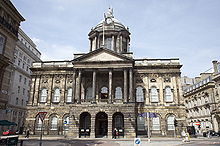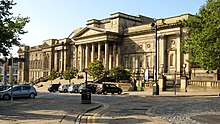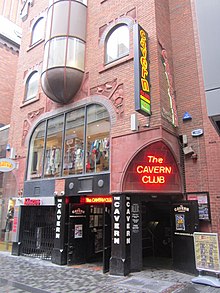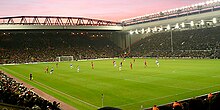Liverpool
| Liverpool | ||
|---|---|---|
|
View from the Mersey to Liverpool center (2012) |
||
| Coordinates | 53 ° 25 ′ N , 2 ° 59 ′ W | |
| OS National Grid | SJ3490 | |
|
|
||
| Traditional county | Lancashire | |
| resident | 500,474 (as of June 30, 2020) | |
| surface | 111.84 km² (43.18 mi² ) | |
| Population density: | 4475 inhabitants per km² | |
| management | ||
| Post town | LIVERPOOL | |
| ZIP code section | L. | |
| prefix | 0151 | |
| Part of the country | England | |
| region | North West England | |
| Shire county | Merseyside | |
| Ceremonial county | Lancashire | |
| Metropolitan Borough | Liverpool | |
| ONS code | 00BY | |
| Website: www.liverpool.gov.uk | ||
|
|
||
| status |
Metropolitan Borough City (1880) |
Liverpool [ ˈlɪvəpuːl ] is a city of around 500,000 people and a metropolitan borough in north-west England . Liverpool is at the mouth of the River Mersey and the Irish Sea . The agglomeration of Liverpool Urban Area is home to around 860,000 residents. Liverpool has the UK's second largest export port .
The historical part of the port city was a World Heritage Site from 2004 to 2021 . The city is known for the traditional football clubs FC Liverpool and FC Everton as well as for its creative music scene, from which, among other things, the Beatles originated. In 2008 Liverpool was - together with the Norwegian Stavanger - European Capital of Culture .
Liverpool residents are officially called the Liverpudlians . In addition, there is also the slang term Scousers , after the dialect spoken in Liverpool Scouse , the name of which is derived from the local stew specialty Scouse .
geography
location
Liverpool is located at the mouth of the Mersey and the Irish Sea, around 280 kilometers north-west of London . It borders Bootle and Aintree (Metropolitan Borough Sefton ) to the north and Kirkby , Huyton , Prescot and Halewood ( Metropolitan Borough of Knowsley ) to the east . On the opposite side of the Mersey, to the west, are the towns of Birkenhead and Wallasey (Metropolitan Borough Wirral ). Greater Liverpool is called Merseyside .
climate
Liverpool has a temperate maritime climate with cool summer and mild winter months. The number of rainy days averages 181 days per year compared to the UK average of 154.4 rainy days. Snowfalls are relatively rare with an average of 22 days a year.
| Liverpool | ||||||||||||||||||||||||||||||||||||||||||||||||
|---|---|---|---|---|---|---|---|---|---|---|---|---|---|---|---|---|---|---|---|---|---|---|---|---|---|---|---|---|---|---|---|---|---|---|---|---|---|---|---|---|---|---|---|---|---|---|---|---|
| Climate diagram | ||||||||||||||||||||||||||||||||||||||||||||||||
| ||||||||||||||||||||||||||||||||||||||||||||||||
|
Average monthly temperatures and rainfall for Liverpool
Source:
|
|||||||||||||||||||||||||||||||||||||||||||||||||||||||||||||||||||||||||||||||||||||||||||||||||||||||||
City structure
Well-known districts of Liverpool in addition to the city center include Anfield, Chinatown, Edge Hill, Everton, Garston, Kirkdale, Mossley Hill, Speke, Toxteth, Walton, Wavertree, West Derby and Woolton.
The city has been divided into 30 municipal electoral districts ( wards ) since 2003 :
story

Around 1190 the place was known as "Liuerpul", which means "muddy pool" or "muddy bay". Liverpool's origins date back to 1207 when the settlement was declared a market town and port. Originally the city served as a base for troops deployed in Ireland . Liverpool Castle was built around 1230 but was demolished in 1726. For four centuries, Liverpool was relatively insignificant.
By the mid-16th century the population was only about 500, and the area was far less important than Chester further south until about 1650 . In 1571, the residents asked Queen Elizabeth I for tax cuts and referred to their city in the petition as "Liverpool, Her Majesty's poor, run-down city".
Until the end of the 17th century, the city barely grew and little happened. The exception in 1644 was an eighteen-day siege by the troops of Ruprecht von der Pfalz, Duke of Cumberland during the English Civil War .
In 1698 the lower house granted the citizens the right to build a new church. After that, Liverpool began to rise to become one of the most important cities in the country. As trade with the West Indies increased , the city began to grow. Large profits from the slave trade contributed to growth and prosperity. When the movement to abolish the slave trade began in Great Britain in 1787 , the slave market in Liverpool was considered the largest in the world.
At the beginning of the 19th century, 40 percent of world trade was transacted through the port of Liverpool. Between 1830 and 1930 around nine million (out of 40 million) Europeans took an emigrant ship starting in Liverpool to a country in the “New World”, most of them to the USA , Australia or New Zealand. Large quantities of steel and textiles , produced in cities like Manchester , Sheffield or Leeds , were exported from Liverpool, particularly to the countries of the Commonwealth . In 1829 George Stephenson built the first Liverpool to Manchester railroad . In 1850 Liverpool became a bishopric and in 1880 Liverpool received city rights . Under the leadership of the ship's owner Sir Alfred Lewis Jones , the Liverpool School of Tropical Medicine , which is now part of the university, was founded in 1898 . In 1911 Liverpool was elevated to an archbishopric .
Growth continued in the first half of the 20th century and the city attracted immigrants from all over Europe, especially Ireland . In 1930 the city had 850,000 inhabitants. During the Second World War , Liverpool was attacked by German bomber units in the Battle of Britain in 1940/41 and was seriously damaged. A bombed church was not rebuilt as a memorial. 2,500 residents were killed and 11,000 injured. From 1939 to 1945 the city was the end point of the important transatlantic SC and HX convoys .
After the Second World War, a major reconstruction program followed with numerous new residential quarters. In the 1950s, Liverpool's importance as a port and industrial location declined continuously. In 1972 Seaforth Dock opened, the most important port project in Great Britain at the time. By 1985 the population had dropped to 460,000.
Historically, Liverpool belonged to the traditional county of Lancashire until 1888 (similar to a "county borough" independent city ) was. In 1974 Liverpool became a metropolitan borough within Merseyside , a newly created metropolitan county .
The economic decline in the 1970s and 80s, which is still visible in the cityscape today, is considered to be one reason for the heavy riots in Toxteth in 1981, which lasted several days. This district in the southeast of Liverpool was characterized by Victorian workers' housing estates, social housing and a high proportion of migrants. Between 1984 and 1987 the dispute between the Tory government under Margaret Thatcher and the Liverpool City Council, in which Trotskyist sections of the Labor Party (“Militant Tendency”) had a majority, received national attention . There were several large demonstrations and strikes. The conflict ended in 1987 with the impeachment of the city council by state auditors.
Liverpool's economy has grown since the 1990s. Numerous jobs were created, especially in the services and tourism sectors .
In 2008 Liverpool was European Capital of Culture . In the “Kings Docks”, the multifunctional hall Echo Arena Liverpool with 10,000 seats was opened in the spring of 2008 . The Museum of Liverpool was built in the Mersey Docks ; it has replaced the old Museum of Liverpool Life since 2011 .
In 2010 a beach on the south coast of Livingston Island in Antarctica was named Liverpool Beach .
Liverpool is a hotspot of the COVID-19 pandemic in the UK .
politics
In May 2012, Joe Anderson was elected first Mayor of Liverpool by the Labor Party. This office had previously been established by a resolution of the city council.
The city council was controlled by the Liberal Democrats for a long time , until Labor emerged as the strongest force in 2010 . The latter was able to expand its seats in the city parliament. Currently (as of 2021) Labor has 70 out of 90 seats. There is no conservative on the city council.
Culture and sights
Buildings
At the time of construction, the port district of Liverpool was considered one of the most modern ports in the world and was on the list of World Heritage Sites by UNESCO from 2004 to 2021 . The most popular areas of the port are the Albert Dock and the Pier Head , on the area of which the distinctive buildings of the Three Graces ( Royal Liver Building , Cunard Building , Port of Liverpool Building ) are located. From 2012 to 2021 this world heritage was on the Red List of World Heritage in Danger . According to UNESCO, the reason for the withdrawal of the World Heritage status is the slow decay of the entire complex due to inadequate maintenance and construction measures in the area, which has a negative impact on the visual integrity of the entire complex. In 2021, the World Heritage Committee recommended that the port district be withdrawn from World Heritage status at the 44th annual session in July 2021. The disintegration, which also accelerated the construction of the Bramley-Moore Dock Stadium for Everton FC in the harbor district, led to the withdrawal of the status as a World Heritage Site in 2021.
Liverpool has two cathedrals. The Protestant neo-Gothic Liverpool Cathedral was built between 1904 and 1978 and is considered one of the largest sacred buildings of that era. The Roman Catholic Liverpool Metropolitan Cathedral was completed in 1967.
Other important buildings are Speke Hall , a half-timbered mansion with gardens from 1598, the neoclassical St. George's Hall (built 1840 to 1855), Chinatown and the West Derby Village Cross .
Museums
Liverpool has several large museums. In 1988 the Tate Liverpool was built in a converted warehouse in Albert Docks, a branch of Tate Modern in London. In the Albert Dock on the waterfront, the Maritime Museum are Merseyside Maritime Museum and the Beatles museum The Beatles Story , as well as the Slavery Museum . The Walker Art Gallery is one of the largest English art collections, showing paintings and sculptures from the past 600 years. The World Museum Liverpool deals with Egyptology, ethnology and the natural sciences. The Maritime Museum, the Walker Art Gallery and the World Museum are part of the National Museums Liverpool , which can be visited free of charge. This includes the new Museum of Liverpool , which opened on July 19, 2011. The building, a £ 72 million construction , is the work of Danish architect Kim Herfoth Nielsen.
The Liverpool Biennial International Art Festival takes place every other year from September to November . The John Moore Painting Prize is awarded at the Biennale .
Music, festivals, theater, motion picture theater
Liverpool is known for its vibrant music scene that has existed since the 1960s. Rock 'n' roll music called Merseybeat was spread from Liverpool . The city is the founding place of many well-known music groups. The rock group The Beatles were founded in Liverpool in 1960, which is why Liverpool was marketed as the "City of the Beatles" for a long time. In town there is a replica of the yellow submarine that became famous from the Beatles' animated film and song Yellow Submarine . Other well-known bands from Liverpool are Orchestral Maneuvers in the Dark , Atomic Kitten , Anathema , Billy J. Kramer & the Dakotas , The Boo Radleys , Carcass , Cast , The Christians , Echo & the Bunnymen , The Farm , Frankie Goes to Hollywood , Gerry & the Pacemakers , The Icicle Works , The La’s , The Lightning Seeds , The Merseybeats , The Scaffold , Rory Storm & the Hurricanes , The Searchers , Space , The Wombats and The Zutons . The best-known music club is the Cavern Club , which opened in 1957 and has become famous for its rock'n'roll concerts.
Liverpool is home to a symphony orchestra, the Royal Liverpool Philharmonic Orchestra , which, in addition to a youth orchestra, regularly gives concerts in the Philharmonic Hall .
The most important cultural event is the Liverpool Shakespeare Festival , which takes place in Liverpool Cathedral and in several city theaters. The Liverpool Empire Theater is the largest theater in Liverpool, it was built between 1866 and 1925.
Church Road North in Wavertree is home to the Abbey Cinerama Theater , an art deco theater formerly known as The Abbey , near which George Harrison lived as a child.
training
The University of Liverpool , Liverpool John Moores University and Liverpool Hope University are the three universities of Liverpool. Liverpool Hope University was founded in 1844 and is the city's oldest university, with its headquarters in Childwall. The Liverpool John Moores University emerged from the Liverpool Polytechnic, which received university status in 1992 and has since been named after the businessman John Moores .
The Institute of Tropical Medicine, the Liverpool School of Tropical Medicine , is affiliated with the University of Liverpool. The institute, which is still renowned today, is the world's first tropical school. The work of the Nobel Prize winner Sir Ronald Ross , who found the first effective anti- malarial drug, is particularly connected to the school . Further scientific achievements of the Tropical Institute are the investigation of the malaria disease and the discovery of the onchocerciasis transmission path.
Sports
Liverpool is home to two football clubs in the Premier League play, the Liverpool and Everton . It is the only British city that has had at least one first division team on a permanent basis since the Football League was founded in 1888.
Liverpool FC is considered one of the most successful English football teams. The club won 19 league titles, six UEFA Champions League (or national champions' cup) and three UEFA Europa League (or UEFA Cup) titles. The home stadium has been Anfield since the club was founded , which has had 54,074 seats since the renovation in 2016. The supporters of Liverpool FC - especially in the standing room The Kop - made a significant contribution to the development of the now classic football fan culture of the 1960s and 1970s (chants, scarves, etc.). Everton FC is the oldest professional football club in Liverpool and has played at Goodison Park with 39,572 seats since 1892 . With nine championship titles, five FA Cup victories and one success in the Cup Winners' Cup, however , the "Toffees" are less successful than their eternal rival from Anfield.
In the British Basketball League , Liverpool is represented by the Everton Tigers . North of Liverpool, in the suburb of Aintree , is a horse racing track, on which the Grand National is held annually.
business
The decline in the industrial sector since the 1950s has created serious economic and infrastructural problems in Liverpool. In particular due to the loss of importance as the central port and trading city of Northern England, unemployment rose to over 90 percent in some poorer neighborhoods in the 1970s. In the mid-1980s, Liverpool became insolvent due to high social benefits. The loss of jobs has been offset by a boom in the service sector, but Liverpool is still one of the ten poorest cities in the UK.
Major banks and financial institutions have offices in the city, including Barclays , JPMorgan , Royal Bank of Scotland and Bank of Ireland . The SCE Studio Liverpool , a subsidiary of Sony Computer Entertainment , has its headquarters in the city. In addition to private sector services, branches of government agencies and institutions were opened in Liverpool, such as the NHS health authority , the Criminal Records Bureau and the passport authority Identity and Passport Service .
Tourism has developed into another important economic sector and favored an upswing in retail, gastronomy and the hotel industry. The buildings of Liverpool are considered attractive film locations and are used as a backdrop for other cities and locations. With around 1000 productions a year, it is the second most filmed city in Great Britain, for example the feature film Across the Universe by Julie Taymor was shot in Liverpool. In total, the culture and film industries employ over 20,000 people in the Liverpool area.
traffic
There are three tunnels under the Mersey to Birkenhead , a rail tunnel and two road tunnels. The Mersey ferry crosses the river, made famous by Gerry & the Pacemakers' song Ferry Cross the Mersey ; it is played every time shortly after the ferry leaves the port. In 2002, 716,000 passengers used the port. From here ferry boats operate to the Isle of Man and Ireland .
In 2001, Speke Airport in Liverpool was renamed John Lennon Airport - in homage to John Lennon , who had been murdered 20 years earlier. The airport logo consists of a sketch drawn by Lennon himself and the words "Above us only sky", which come from his famous song Imagine (1971).
Liverpool has a S-Bahn- like rail network called Merseyrail ; the sections in the city center are mostly underground. The Liverpool Overhead Railway closed in 1956. The city's main train station is Lime Street . The once extensive tram network also disappeared in the 1950s .
Personalities
Town twinning
-
 Shanghai , People's Republic of China
Shanghai , People's Republic of China
-
 Corinto , Nicaragua
Corinto , Nicaragua
-
 Cologne , Germany
Cologne , Germany
-
 Dublin , Ireland
Dublin , Ireland
-
 Odessa , Ukraine
Odessa , Ukraine
-
 Rio de Janeiro , Brazil
Rio de Janeiro , Brazil
-
 Birmingham, Alabama , United States
Birmingham, Alabama , United States
literature
- John Belchem (Ed.): Liverpool 800. Character, Culture and History. Liverpool University Press, 2006, ISBN 1-84631-036-9 .
- John Belchem (Ed.): Popular Politics, Riot And Labor. Essays In Liverpool History 1790-1940. Liverpool University Press, 1992, ISBN 0-85323-427-2 .
- Bill Harry: Bigger Than The Beatles Trinity Mirror North West & North Wales, 2009, ISBN 1-906802-04-1 .
- Quentin Hughes: Liverpool - City of Architecture. The Bluecoat Press, 1999, ISBN 1-872568-21-1 .
- Arthur Johnson: Merseyside's Secret Blitz Diary - Liverpool at War. Trinity Mirror Merseyside, Liverpool 2005, ISBN 0-9546871-9-1 .
- Jessica Moody: The persistence of memory: Remembering slavery in Liverpool, 'slaving capital of the world'. Liverpool University Press, Liverpool 2020, ISBN 978-1-78962-232-4 .
- Peter Wuhrer: Freedom is tough and dies endlessly - Liverpool - through the destruction of a region . Rotbuch, Berlin 1983, ISBN 3-88022-269-X .
Movie
- The transformation. Blackpool, Liverpool, Manchester, Leeds. Documentation, 45 min., 2005, a film by Peter M. Kruchten, production: Saarländischer Rundfunk , summary ( memento from June 22, 2008 in the Internet Archive )
Individual evidence
- ↑ Mid 2020 Estimates of the population for the UK, England and Wales, Scotland and Northern Ireland
- ↑ Iten-Online.ch / Liverpool
- ^ World Weather Information Service. Retrieved July 16, 2019 .
- ↑ STATUTORY INSTRUMENTS 2003 No. 2505 LOCAL GOVERNMANE, ENGLAND: The City of Liverpool (Electoral Changes) Order 2003 , accessed December 14, 2015.
- ↑ Florence Baggett (2013): The Slaving Capital in the Era of Abolition: Liverpool's Silent Rejection of the Slave Trade, 1787-1807 . Thesis, Victoria University of Wellington, online (pdf), page ii
- ^ Emigrants to a New World gallery - Merseyside Maritime Museum, Liverpool museums. Retrieved September 19, 2017 (UK English).
- ^ Church of St Luke, Picture Gallery
- ↑ Liverpool economic briefing ( Memento of the original dated August 14, 2017 in the Internet Archive ) Info: The archive link was inserted automatically and has not yet been checked. Please check the original and archive link according to the instructions and then remove this notice. (Link list); Liverpool Economic Briefing 2016 (p. 30 ff.)
- ↑ see also Economy of Liverpool; Briefing 2016 , p. 17 f.
- ^ Museum of Liverpool, Liverpool museums. Retrieved September 19, 2017 (UK English).
- ↑ www.liverpool.gov.uk: Coronavirus cases by area (October 13, 2020)
- ↑ spiegel.de October 13, 2020
- ↑ liverpool.gov.uk: Mayor of Liverpool elected (May 4, 2012)
- ↑ BBC NEWS | Election 2010 | Liverpool council. Retrieved September 19, 2017 (UK English).
- ↑ http://whc.unesco.org/en/list/1150 Entry on the List of World Heritage in Danger of the UNSECAO (English)
- ↑ Unesco report says Liverpool should lose World Heritage status . BBC, June 22, 2021
- ↑ Draft Decision: 44 COM 7A.34
- ↑ Unesco strips Liverpool of its world heritage status , Guardian article of July 21, 2021
- ↑ BBC News from July 19, 2011 (English)
- ↑ The Guardian of July 24, 2011 (English)
- ↑ website .
- ↑ Brian Roylance, Nicky Page, Derek Taylor (Eds.): The Beatles Anthology. Chronicle Books, San Francisco 2000; as a translation from English: Ullstein, Munich 2000. ISBN 3-550-07132-9 , p. 25.
- ↑ New Anfield capacity confirmed as 54,074 . In: Liverpool FC . ( liverpoolfc.com [accessed September 19, 2017]).
- ↑ Edgar Klüsener: Liverpool: With culture out of the crisis. In: Spiegel Online . January 5, 2004, accessed February 27, 2015 .
Web links
- Official Liverpool City Council website
- World Heritage Site - Liverpool (English)
- Visit Liverpool (English)
- Port of Liverpool (English)
- Albert Dock complex Liverpool (English)





























